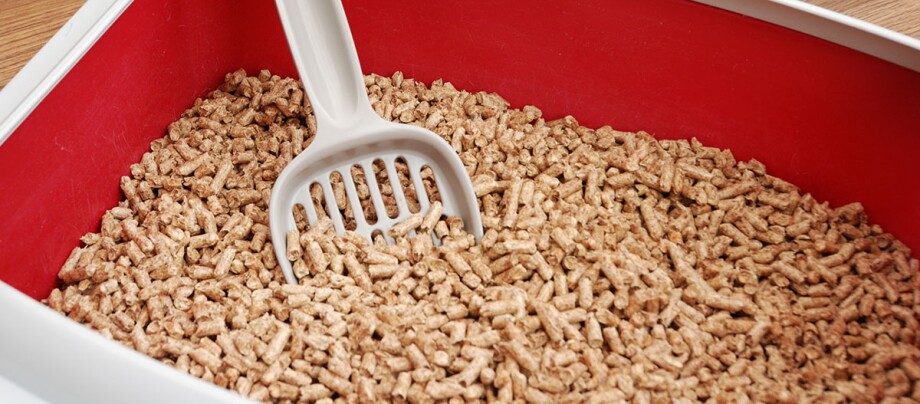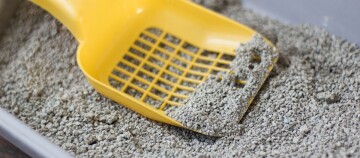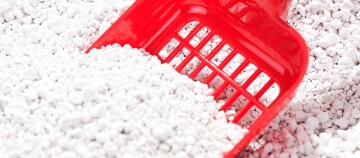How Easy It Is to Clean a Cat Toilet - Practical Hygiene Tips
14.11.2022 - Reading time: 5 minutes

When the weather outside is dreary, cat owners have a distinct advantage: unlike dog owners, they don’t have to go out in the wind and rain for walkies. Cats take care of their business discreetly in their own cat toilet in the home. However: this practical hygiene facility for house cats requires careful cleaning. With the right technique, you will quickly become a pro. Find out just how easy it is to clean a cat toilet.
How often should I clean the cat toilet?
Did you know that an adult cat visits the toilet around seven times a day? Naturally, the frequency varies based on individual habits and feeding, but cats excrete, on average, urine five time and faeces twice per day.
If there are multiple cats in the house, the daily volume of cat excrement increases accordingly. Because the digestive products of this carnivore and the concentrated urine produce a very pronounced odour, in the interest of all concerned, you should ensure that the cat toilet is always clean. The cat itself especially feels uncomfortable with a dirty toilet. It is then possible that the animal with switch to other places in the house to take care of its necessary business. This may be flower pots, the sofa or carpets.
If each cat has it’s own toilet, you should clean each one once, ideally twice per day. If a larger group of cats shares the toilet – which is not optimal – you absolutely must remove the excrement multiple times a day. Depending on the type of litter and fill level, it should be thoroughly cleaned every one to two weeks. For more on this, see below.
What do I need to clean the cat toilet?
A basic equipment aside from the cat toilet itself, you need a special kitty litter shovel with a lattice pattern cut in the blade.
Leavings can be sealed hygienically and odour-free in special cat poo bags, and a cat litter bucket is useful for short-term storage. The cat faeces can be kept there until the next trip to the bin.
For your personal hygiene when working, cleaning gloves and a respirator should be available. The latter is especially important when using litter than produces a certain amount of dust.
Finally, you need kitty litter as a consumable. Because the selection of the optimal variety for you is a minor science of its own, you can find comprehensive information in the advisor “Kitty Litter Tips”.
Cleaning the cat toilet: step by step
Have you got your cat litter shovel and rubbish bag ready? Than you can get started with cleaning the cat toilet.
- If present, lift the cover of the cat toilet and dig around in the litter with the shovel. If you find faeces, sieve it out of the litter.
- Depending on the litter, there may be balls of urine in the toilet that can also be found this way.
- Once you have removed all of the solid excrement reside from the the tub, you can stir the remaining litter with the shovel.
- Finally, refill the tub with fresh litter. It is important, however, that the fill level does not change too much – that might confuse your cat.
Every one to two weeks, the cat toilet should be thoroughly cleaned. This means that the litter is replaced completely. This provides an opportunity to wash and disinfect the plastic tub.
- Pour the entire contents of the cat toilet into the rubbish bag.
- Then rinse out the tub with warm water and remove any remaining encrustation with a sponge.
- There is no reason not to use a mild neutral cleaner: just be sure that the cleaner does not damage to plastic or leave any potent odours. Citrus scents and ammonia are particularly irritating to cats.
- Let the tub dry. Ensure that there is no residual moisture before refilling it with litter since the litter becomes unusable if it comes into contact with water.
Your purring companions with have nothing to complain about with a toilet cleaned in this way.
Why does the cat toilet stink?
It is possible, despite every attempt at cleaning, that the cat toilet smells unpleasant. What should you do in this case – and where is the cat toilet odour coming from?
The smell of cat urine and faeces is not particularly pleasant in itself, on top of which some cats give off their own individual “scent”. The high-tech solution consists of a closed cat litter box with an active carbon filter that binds the odour particles. Even a normal bonnet can retain most odours, but not every cat takes kindly to a closed litter box.
Unpleasant odours are more likely to develop if you use clay granules as litter, as they are not as effective at binding odours. This can be remedied by sprinkling ordinary baking soda on the floor of the litter tray before filling it with litter. Some “odour stoppers” for litter trays promise a similar result, but with an additional disinfecting effect, although it is possible that a sensitive cat literally “can’t smell” these cleaning agents and will thus boycott the litter tray.
To eliminate or at least mask the smell of the litter tray, you can use air fresheners, but again, avoid citrus scents.
How should I dispose of the old cat toilet?
Sooner or later a litter tray will have served its purpose or need to be replaced by a new model, and the question arises as to how to dispose of it properly. If the litter box is still in serviceable condition and not damaged, some animal welfare organisations or animal boards will gladly accept it as a donation, or a potential buyer may be found through a classified ad. However, if the litter tray is broken or badly worn, it should be disposed of in the bulky or residual waste. Unfortunately, this type of plastic is not recyclable.



